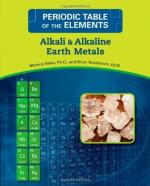|
This section contains 1,320 words (approx. 5 pages at 300 words per page) |

|
On the Periodic table, Group 2 (IIA) consists of beryllium, magnesium, calcium, strontium, barium, and radium. This family of elements is known as the alkaline earth metals, or just the alkaline earths. Although early chemists gave the name "earths" to a group of naturally occurring substances that were unaffected by heat and insoluble in water, the alkaline earth metals are also usually found in the continental crust. In contrast, Group 1 compounds and ions tend to concentrate in the ocean.
Calcium carbonate is geologically evident as limestone, marble, coral, pearls, and chalk—all derived mainly from the shells of small marine animals. The weathering of calcium silicate rocks over millions of years converted the insoluble calcium silicate into soluble calcium salts, which were carried to the oceans. The dissolved calcium was used by marine organisms to form their shells. When the organisms died, the shells were...
|
This section contains 1,320 words (approx. 5 pages at 300 words per page) |

|


